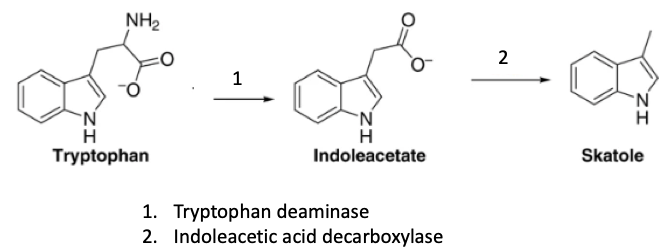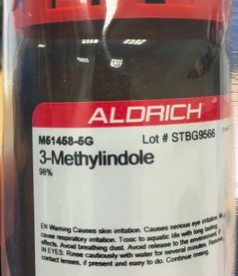There are about 20 million known organic chemicals, so it should not be at all surprising that there are some pretty strange dudes floating around in that huge group. Here is one of them; it fits the term "strange" and then some.
It is called skatole (aka 3-methylindole) and it has something for everyone – people who are made of protein, use cologne or perfume, eat strawberry ice cream, smokers, those who have a sense of smell and some rather odd folks who are into some unspeakably nasty sexual practices. (Rumor has it that one member of ACSH staff falls into the last category, but I shall say no more.)
1. Some revolting facts about skatole

Talk about versatile!
Good luck finding another chemical that:
- Can smell either very good or very bad.
- Goes in one end and comes out the other.
- And is added to a few foods to make them taste better (!)
- Its name is derived from skatos – Greek for dung. If you dare, go to the Urban Dictionary and look up "skat." Just don't say that I didn't warn you because it's 50 Shades of Disgusting.

She did not heed the warning #4. Photo: Health eNews
2. How is skatole formed?
Skatole is formed from the breakdown (metabolism) of the amino acid tryptophan by bacteria in the gut and mouth. The metabolism involves two consecutive enzymatic transformations: deamination (replacement of an amino group by hydrogen) followed by decarboxylation (replacement of a carboxylic acid group by hydrogen). Both of these reactions can be found in any first-year biochemistry textbook.

The enzymatic conversion of tryptophan to skatole involves two distinct steps, each catalyzed by specific enzymes in bacteria that are found in the gut and the mouth (ick). Deamination and decarboxylation are common metabolic pathways; their mechanisms are well-understood.
3. Skatole has a bipolar scent
In my career, I had to use skatole exactly once. Although organic chemists are exposed to the most ungodly smells on a regular basis this one scared me more than a little. Its reputation precedes it. But at least it comes well-wrapped.

Skatole from Sigma-Aldrich comes in a double-sealed bottle. And you can sometimes still smell it.
Despite opening the bottle well inside the fume hood I still caught a whiff of the stuff. My reaction was odd – two reactions, in fact. They were quite different:
1. "This stuff isn't so bad."
2. "Kill me."
Both are actually normal. In very low concentrations skatole is described as smelling like orange blossoms and jasmine and is added to perfumes and colognes. But in higher concentrations, it lives up to its name. Like someone dropped a deuce in your briefcase.
This is why skatole is used in perfume.
4. Listerine ain't gonna touch this
Since the degradation of tryptophan is promoted by a dozen strains of bacteria in the gut and in the mouth some unfortunate individuals suffer from the latter. It does not help their social lives. There's even a study that examines the composition breath of people with normal breath and those who could take the heat shields off spacecraft.

A study of the components of bad breath. Skatole and three other stinky chemicals were measured. Only the skatole measurements are included. Subjects S1-S5 have normal breath. Note the low measured concentrations of skatole in the breath. Subjects OM1-OM3 (OM = oral malodor) exhale considerably more skatole with the exception of OM3. **Although s/he is "skatole-light" this individual had very high levels of hydrogen sulfide (rotten eggs) and methyl mercaptan (farts). Photo: California East Bay Pioneers
5. Can't top this quote
Perhaps the most famous perfume to feature skatole in doses that should perhaps be illegal was Nuit de Chine (Chinese Nights) by Maurice Schaller in 1913 for Les Parfums de Rosine. Nuit de Chine was a fougere (fern) type perfume built around a core of sandalwood, skatole, peach, and rose. When you smell this fragrance, the skatole makes its presence known from the get-go, but it is so perfectly balanced with the other ingredients that you can’t stop sniffing it.
Top 10 Bizarre Ingredients In Perfume, Listverse, 2016
Speak for yourself.
6. Other strange uses
Skatole is one of the 599 chemicals added to cigarettes (for flavor). If this isn't enough to get you to stop smoking...
And someone discovered that a little skatole makes strawberry ice cream taste better. This begs a couple of questions...
- Who the hell came up with that idea???
- Why?
- How was this, uh, ingredient added?
- Am I the only one who thinks that we now need a distinction between the terms "synthetic" and "man-made?" Think about it. Skatole in the bottle is synthetic. It can easily be made by a 140-year old reaction called the "Fischer Indole Synthesis (1)." But (at least until this moment) "man-made" and "synthetic" have been synonymous. This might diminish the appeal of strawberry ice cream, no?
 ›
›
This woman is having a bad day. If you send flowers please make sure there's no jasmine in there.
NOTE:
(1) The Fischer Indole Synthesis is the reaction of a phenylhydrazine with an aldehyde or ketone using an acid catalyst. It was invented by Emil Fischer in 1883. His lab probably didn't smell so great.





